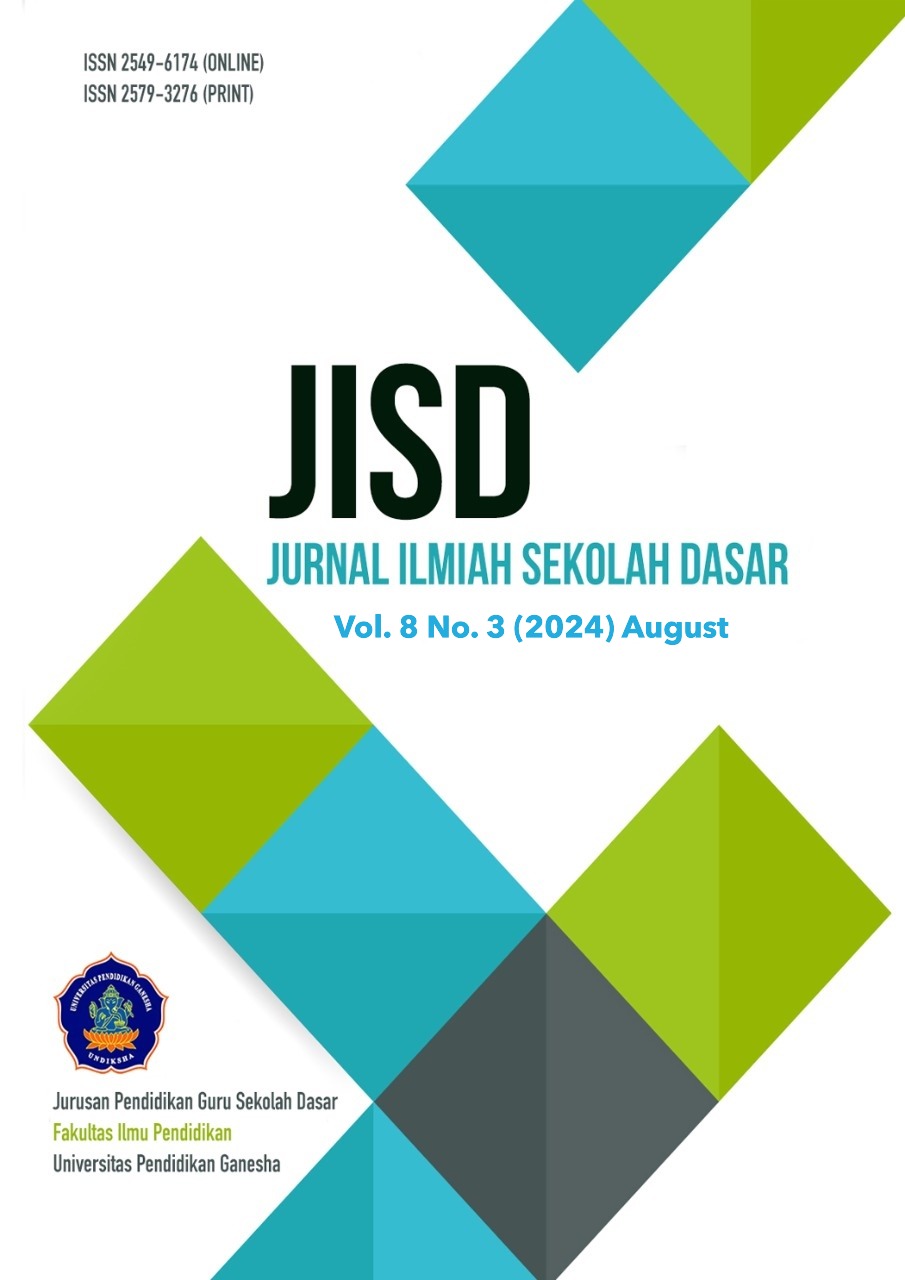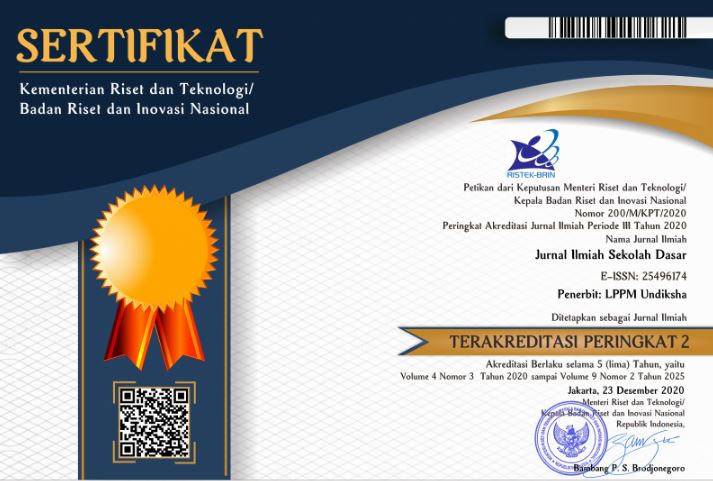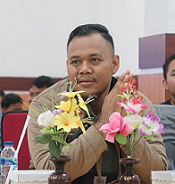Improving Elementary Students' Reading Skills Through the Cooperative Integrated Reading and Composition Method
DOI:
https://doi.org/10.23887/jisd.v8i3.71995Keywords:
Student, CIRC Learning Model, Reading SkillsAbstract
Reading skills are crucial for everyone, especially for elementary school students. Currently, reading difficulties are commonly encountered, with many students struggling with reading comprehension due to suboptimal reading skills. This study aims to examine the impact of the Cooperative Integrated Reading and Composition (CIRC) learning model on students' reading skills. The research method used is quantitative with a quasi-experimental design. The design applied is a Non-Equivalent Control Group Design with pre-test and post-test. Participants in this study were fifth-grade elementary school students, with a sample of 37 students selected using purposive sampling. These students were divided into two groups: the experimental group consisting of 20 students and the control group consisting of 17 students. Data collection was carried out using assessment rubrics, pre-test and post-test, and structured questionnaires distributed to students to measure reading skills using the CIRC learning model. Data were analyzed using inferential statistics. The results showed a significant difference between the experimental and control groups. The significance value (2-tailed) of 0.000 < 0.05 indicates that the Cooperative Integrated Reading and Composition (CIRC) learning model has a positive impact on the reading skills of fifth-grade students. Based on these results, it can be concluded that the CIRC learning model is effective in improving students' reading skills.
References
Afriani, Z. L., Anggraini, M., & Riswanto, R. (2020). The Effect of Question Answer Relationship (QAR) Strategy in Enhancing Students’ Reading Comprehension. Journal of English Education and Teaching, 4(4), 548–558. https://doi.org/10.33369/jeet.4.4.548-558.
Afriyanti, I., Wardono, & Kartono. (2018). Pengembangan Literasi Matematika Mengacu PISA Melalui Pembelajaran Abad Ke-21 Berbasis Teknologi. PRISMA (Prosiding Seminar Nasional Matematika), 608–617. https://journal.unnes.ac.id/sju/index.php/prisma/article/view/20202.
Akhiruddin, A. & A. (2022). Sociology teaching materials development based on the inside out circle model to espouse l earners ’ multiliteracies. Cypriot Journal of Educational Science, 17(12), 4424–4436. https://doi.org/https://doi.org/10.18844/cjes.v17i12.7947.
Al Adawiyah, A. (2023). CIRC Learning Model for Reading Comprehension of French Language. Journal of Languages and Language Teaching, 11(1), 104. https://doi.org/10.33394/jollt.v11i1.6903.
Alokluk, J. (2018). The effectiveness of Blackboard system, uses and limitations in information management. Intelligent Information Management, 10, 133–149. https://doi.org/https://doi.org/10.4236/ iim.2018.106012.
Anggita, A. D., Purnamasari, I., & Rais, R. (2021). Analisis Faktor-faktor yang Mempengaruhi Perilaku Menyimpang pada Anak Usia Sekolah Dasar di SD Negeri Pleburan 03 Semarang. Harmony: Jurnal Pembelajaran IPS Dan PKN, 6(1), 1–5. https://doi.org/10.15294/harmony.v6i1.43951.
Anwar, I. W., & Sailuddin, S. P. (2022). Academic Reading Difficulties in Higher Education. Journal of Languages and Language Teaching, 10(2), 309. https://doi.org/10.33394/jollt.v10i2.4849
Artawan, G. (2020). Narrating in Cooperative Learning Integrated Reading and Composition (CIRC) Learning in Elementary School to Improve Reading Skills. JPI (Jurnal Pendidikan Indonesia), 9(2), 171. https://doi.org/10.23887/jpi-undiksha.v9i2.25270.
Arwen, D., & Haq, S. (2022). The Effect of Cooperative Integrated Reading and Composition Learning Method Towards Fable Writing Skills. English Review: Journal of English Education, 10(1), 323–336. https://doi.org/10.25134/erjee.v10i1.5721.
Awan, U., Shamim, S., Khan, Z., Zia, N. U., Shariq, S. M., & Khan, M. N. (2021). Big data analytics capability and decision-making: The role of data-driven insight on circular economy performance. Technological Forecasting and Social Change, 168(1), 1-39. https://doi.org/10.1016/j.techfore.2021.120766.
Azhari, S. N., Cahyani, I., & Kirana, P. (2019). Application Model Cooperative Integrated Reading and Composition (CIRC) to improve reading somprehension skills of class V elementary school student. International Journal of Science and Applied Science: Conference Series, 3(1), 150. https://doi.org/10.20961/ijsascs.v3i1.32452.
Candra Sari, R., Rika Fatimah, P. L., Ilyana, S., & Dwi Hermawan, H. (2022). Augmented Reality (AR)-Based Sharia Financial Literacy System (AR-SFLS): A New Approach To Virtual Sharia Financial Socialization for Young Learners. International Journal of Islamic and Middle Eastern Finance and Management, 15(1), 48–65. https://doi.org/10.1108/IMEFM-11-2019-0484.
Dewi, D. K., Harlamu, M., & Crist, H. (2023). The Effectiveness of the Cooperative Integrated Reading and Composition (CIRC) Method on Reading Comprehension Ability based on Reading Interest in Grade IV Elementary School Students. International Journal of Research and Review, 10(9), 214–225. https://doi.org/10.52403/ijrr.20230924.
Erkek, G. (2022). Activity Suggestions to Develop Critical Reading and Writing Skills. International Journal of Education and Literacy Studies, 10(2), 65–70. https://doi.org/10.7575/aiac.ijels.v.10n.2p.65.
Firdaus, M., & Mayasari, S. (2022). Schoology-Aided Instruction: Measuring the Effectiveness for Student-Teachers’ Reading Comprehension Achievement. Journal of Languages and Language Teaching, 10(3), 380. https://doi.org/10.33394/jollt.v10i3.5311.
Fırat, T., & Koyuncu, İ. (2021). Investigating Reading Literacy in PISA 2018 Assessment. International Electronic Journal of Elementary Education, 13(2), 263–275. https://doi.org/10.26822/iejee.2021.189.
Frimaulia, S., & Suprayetno, E. (2021). The Effect of Applying Cooperative Integrated Reading and Composition (CIR ) Technique on Students’ Achievement in Writing Recount Text. Journal of Applied Linguistics, 1(1), 17–22. https://doi.org/10.52622/joal.v1i1.36.
Gupta, M., & Ahuja, J. (2014). Cooperative integrated reading composition (CIRC): impact on reading comprehension achievement in English among seventh graders. International Journal of Research in Humanities, Arts and Literature Journals, 2(5), 37–46. http://www.impactjournals.us/download/archives/2-11-1399129002-6. Humanities-Cooperative integrated reading composition-Jyoti Ahuja.pdf.
Haerazi, & Irawan, L. A. (2020). The effectiveness of ECOLA technique to improve reading comprehension in relation to motivation and self-efficacy. International Journal of Emerging Technologies in Learning, 15(1), 61–76. https://doi.org/10.3991/ijet.v15i01.11495.
Hakim, M. A. R., Amrulin, P. K., Zasrianita, F., & Kurniawan, Y. S. (2023). The Implication of Cooperative Integrated Reading and Composition (CIRC) Technique on English Reading Comprehension for Madrasah Aliyah Students. Linguistic, English Education and Art (LEEA) Journal, 6(2), 233–245. https://doi.org/10.31539/leea.v6i2.5814.
Hasibuan, M. S., & Afnita, A. (2022). The Effect of the CIRC and Learning Motivation on Reading Comprehension Skills for Junior High School Students. AL-ISHLAH: Jurnal Pendidikan, 14(4), 5701–5708. https://doi.org/10.35445/alishlah.v14i4.1816.
Hasyim, A., F., U. A., Sari, Y. A., & Puspita, N. (2020). Applying of Cooperative Integrated Reading and Composition (CIRC) Strategy on Students’ Reading Comprehension. Anglophile Journal, 1(1), 41. https://doi.org/10.51278/anglophile.v1i1.80.
Kamaluddin, A., & Rusnilawati. (2022). The Effect Of Quantum Learning Model With Big Book Media On Reading And Writing Skills. Jurnal Ilmiah Sekolah Dasar, 6(4), 568–574. https://doi.org/10.23887/Jisd.V6i4.54444.
Kamdideh, Z., Vaseghi, R., & Talatifard, S. (2019). The Effects of “Reciprocal Teaching of Reading” and “Cooperative Integrated Reading and Composition” on the Reading Comprehension of Iranian EFL Intermediate Students. Theory and Practice in Language Studies, 9(9), 1111. https://doi.org/10.17507/tpls.0909.06.
Karakose, T., Polat, H., & Papadakis, S. (2021). Examining Teachers’ Perspectives on School Principals’ Digital Leadership Roles and Technology Capabilities during the COVID-19 Pandemic. In Sustainability (Vol. 13, Issue 23). https://doi.org/10.3390/su132313448.
Keefe, E. S. (2020). Learning to practice digitally: Advancing pre-service teachers’ preparation via virtual teaching and coaching. Journal of Technology and Teacher Education, 28(2), 223–232. https://doi.org/https://www.learntechlib.org/primary/p/216145/.
Kesumadewi, D. A., Agung, A. A. G., & Rati, N. W. (2020). Model Pembelajaran CIRC Berbantuan Media Cerita Bergambar Meningkatkan Hasil Belajar Bahasa Indonesia Siswa SD. MIMBAR PGSD Undiksha, 8(2), 303–314. https://doi.org/10.23887/jjpgsd.v8i2.25524.
Krawitz, J., Chang, Y.-P., Yang, K.-L., & Schukajlow, S. (2022). The Role of Reading Comprehension in Mathematical Modelling: Improving the Construction of a Real-World Model and Interest in Germany and Taiwan. Educational Studies in Mathematics, 109(2), 337–359. https://doi.org/10.1007/s10649-021-10058-9.
Levrini, O., Tasquier, G., Barelli, E., Laherto, A., Palmgren, E., Branchetti, L., & Wilson, C. (2021). Recognition and Operationalization of Future‐Scaffolding Skills : Results from An Empirical Study of a Teaching–Learning Module on Climate Change and Futures Thinking. Science Education, 105(2), 281–308. https://doi.org/10.1002/sce.21612.
Mariana, E., Sutisna, E., & Wahyuni, A. (2020). The Use of Cooperative Integrated Reading and Composition (CIRC) Technique on Students’ Reading Comprehension. Journal of English Teaching and Linguistics Studies (JET Li), 2(2), 43–51. https://doi.org/10.55215/jetli.v1i2.2474.
Maruf, N., & Anjely, A. M. R. (2020). Utilizing Cooperative Integrated Reading and Composition (CIRC) with mobile Learning to Enhance Students’ Reading Comprehension. British (Jurnal Bahasa Dan Sastra Inggris, 9(2), 10. https://doi.org/10.31314/british.9.2.10-19.2020.
Metekohy, B., Sahertian, N. L., & Ming, D. (2021). Contribution of Token Type Cooperative Learning Models for in the Haruru Christian Middle School. Psychology and Education, 58(2), 982–994. https://papers.ssrn.com/sol3/papers.cfm?abstract_id=3800520.
Miller, T. (2018). Developing numeracy skills using interactive technology in a play-based learning environment. International Journal of STEM Education, 5(1). https://doi.org/10.1186/s40594-018-0135-2.
Monteiro, A., Santos, P. J., & Gonçalves, C. (2019). The Meanings Of Higher Education, Work, And Transition From Higher Education to Work. Análise Psicológica, 37(4), 431–446. https://doi.org/10.14417/ap.1606.
Muhyidin, A., Wahid, F. I., Sobri, S., & Diana, D. (2023). Improving High School Students’ Short Story Reading Outcomes With CIRC Model Assisted Image Media. International Journal Of Humanities Education and Social Sciences (IJHESS), 2(5). https://doi.org/10.55227/ijhess.v2i5.467.
Niati, B., & Rasyidah, U. (2020). The Effect ff Cooperative Integrated Reading Composition (CIRC) on Students’ Writing Critical Essay. Educational Administration Research and Review, 2(2). https://doi.org/10.17509/earr.v2i2.22475.
Norlund, A. (2020). Fiction Reading in a Practice Where L1 and L2 Learners Are Taught Together. Pedagogy, Culture & Society, 28(2), 261–279. https://doi.org/10.1080/14681366.2019.1631208.
Patwa, N., Sivarajah, U., Seetharaman, A., Sarkar, S., Maiti, K., & Hingorani, K. (2021). Towards a circular economy: An emerging economies context. Journal of Business Research, 122(September 2019), 725–735. https://doi.org/10.1016/j.jbusres.2020.05.015.
Paynter, J., O’Leary, K., & Westerveld, M. (2023). Pre-school Skills and School-Age Reading Comprehension in Children on the Autism Spectrum: A Preliminary Investigation. Journal of Autism and Developmental Disorders. https://doi.org/10.1007/s10803-023-05949-0.
Prajogo, M. P., & S. (2021). The Use of Cooperative Integrated Reading and Composition (CIRC) Method to Improve Students’ Reading Comprehension. Konstruktivisme : Jurnal Pendidikan Dan Pembelajaran, 13(1), 78–85. https://doi.org/10.35457/konstruk.v13i1.1613.
Rahmasari, B. S., & Swasti, A. E. (2022). Teaching Reading Using CIRC Method. Journey: Journal of English Language and Pedagogy, 5(2). https://doi.org/10.33503/journey.v5i2.2080.
Ristanto, R. H., Djamahar, R., & Darmawan, E. (2020). Biology Teachers: Knowledge in Authentic Assessment Through Cooperative Integrated Reading and Composition Based Scientific Approach (CIRSA. Indonesian Journal of Science and Education, 4(2), 111. https://doi.org/10.31002/ijose.v4i2.2588.
Sari, N. K., Drajati, N. A., & Rochsantiningsih, D. (2019). Promoting Students’ Reading Comprehension Using Graphic Organizer: A Classroom Action Research. International Journal of Language Teaching and Education, 3(2), 118–129. https://doi.org/10.22437/ijolte.v3i2.7394.
Schröter, H., & Bar-Kochva, I. (2019). Keyword: Reading Literacy. Reading Competencies in Germany and Underlying Cognitive Skills. Zeitschrift Für Erziehungswissenschaft, 22(1), 17–49. https://doi.org/10.1007/s11618-018-00864-y.
Setyowati, F. A., Kristiani, & Murwaningsih, T. (2022). The Effectiveness of Visual Picture Economics Textbook Based on Problem Based Learning in Improving Reading Literacy Skills. Journal of Education Technology, 6(3), 380–389. https://doi.org/10.23887/jet.v6i3.46435.
Shavshishvili, M. (2022). Development of Reading Ability In Childhood by the Example Of Georgian Language. International Journal of Multilingual Education, 11(1), 131–145. https://doi.org/10.22333/ijme.2022.200010.
Supandi, M., & Senam, S. (2019). Mengembangkan keterampilan berpikir kritis dengan game ritual tumpe. Jurnal Inovasi Pendidikan IPA, 5(2), 139–146. https://doi.org/10.21831/jipi.v5i2.25920.
Tamba, R., Naibaho, T. T., & Purnomo, T. W. (2023). The Effect of the CIRC (Cooperative Integrated Reading and Composition) Model on Student Learning Outcomes Theme 6 Class III SDN 106158 Pematang Johar. Indonesian Journal of Advanced Research, 2(6), 725–738. https://doi.org/10.55927/ijar.v2i6.4553.
Tegeh, I. M., Santyasa, I. W., Agustini, K., Santyadiputra, G. S., & Juniantari, M. (2022). Group Investigation Flipped Learning in Achieving of Students’ Critical and Creative Thinking Viewed from Their Cognitive Engagement in Learning Physics. Journal of Education Technology, 6(2), 350–362. https://ejournal.undiksha.ac.id/index.php/JET.
Telaumbanua, M. (2021). The Application of the Cooperative Integrated Reading and Composition (CIRC) Learning Model in Improving the Ability to Find Elements of the Nonfiction Book for Class VII Students of SMP Negeri 1 Ma’u Nias Regency 20202021 Learning Year. IJEMS:Indonesian Journal of Education and Mathematical Science, 2(1), 51. https://doi.org/10.30596/ijems.v1i3.5444.
Thyer, B. A. (2012). Quasi-Experimental Research Design. Oxford University Press, Inc.
Venkatesh, V. (2003). User Acceptance of Information Technology: Toward A Unified View. MIS Quarterly, 47(2), 425–478. https://doi.org/10.1006/mvre.1994.1019.
Wahyuningsih, A., & Citraningrum, M. (2019). The Effectiveness of The Cooperative Integrated Reading and Composition (CIRC) and Preview Question Read Reflect Recite Review (PQ4R) on Reading Comphrehension Skill. Indonesian Journal on Learning and Advanced Education (IJOLAE), 1(1), 26–36. https://doi.org/10.23917/ijolae.v1i1.7383.
Wongsuwan, N., & Regiana, A. A. (2023). Examining the Effect of Cooperative Integrated Reading and Composition (CIRC) on Students’ Reading Comprehension. International Journal of Research in Education, 3(1), 51–61. https://doi.org/10.26877/ijre.v3i1.13591.
Downloads
Published
How to Cite
Issue
Section
License
Copyright (c) 2024 Paskalia Wae, Herwin

This work is licensed under a Creative Commons Attribution-ShareAlike 4.0 International License.
Authors who publish with the Journal Ilmiah Sekolah Dasar agree to the following terms:
- Authors retain copyright and grant the journal the right of first publication with the work simultaneously licensed under a Creative Commons Attribution License (CC BY-SA 4.0) that allows others to share the work with an acknowledgment of the work's authorship and initial publication in this journal.
- Authors are able to enter into separate, additional contractual arrangements for the non-exclusive distribution of the journal's published version of the work (e.g., post it to an institutional repository or publish it in a book), with an acknowledgment of its initial publication in this journal.
- Authors are permitted and encouraged to post their work online (e.g., in institutional repositories or on their website) prior to and during the submission process, as it can lead to productive exchanges, as well as earlier and greater citation of published work. (See The Effect of Open Access)










